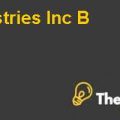Bain Capital-Outback Steakhouse Case Study Solution
Introduction:
This case is mainly dealing with a well-known Boston based private equity firm which is operating globally and it was incorporated in 1984 under the brand name Bain capital. It started to grow its business and making investments in other companies which lead the company to invest in 230 companies an amount of around forty billion dollars in the year 2008 and it was making strategic alliances with other firms by acquiring them throughout the world.
Areas of investment of the company were mainly in growth capital, start-ups, growing companies and turn around opportunities across all the available sectors in the territory of the company. The sponsorship of the company was mainly in leveraging the recapitalizations and acquisitions such as traditional buyouts and capital growth in certain industries. The company is also involved in raising private equity funds which have reached to around 10 core funds raised by the company throughout its history so far and the company is still involved in raising the funds. This leads to the fundraising of around 11.8 billion dollars recently.
If we analyze the industry trends for raising the funds, the company would be ranked highest in the industry in terms of raising funds and investing in mature equity funds which havereceived ahigher return on its invested assets.
Distinct capabilities of Bain capital:
If we analyze the company with respect to its competitors, Bain capital has maintained a distinct position in the minds of its consumers as the buyer of value added. It means the policy of the company is to evaluate another company in which company is planning to invest by analyzing it critically through the measures of strategic as well as the opportunities to evaluate its operations.
This will result in the less emphasis of the company over the higher return generation from its investments which is just the financial highlight or financial goals. This lead to the company’s objectives to approach the investment opportunities by evaluating strategically for bringing the changes in the portfolio of the company after analyzing its available options and situation.
The company prefers to invest in those companies which provide definite plans for improvising the profits and growth opportunities as well as possesses the competitive edge over others. Moreover, the company tries to make its policy people oriented rather than performance oriented. The growth and brand image of the company resulted in the acquisition of the famous and well-known pizza chain Domino’s in the year 1998 and it acquired Dunkin doughnuts in the year 2006 by apartnership with others whereas, it also acquired by investing through leverage buyout a well-known brand Burger King at around 1.5 billion dollars.
Overview of Outback Steakhouse:
In the year 2007, Bain Capital acquired a well-established restaurant chain named as Outback Steakhouse which is famous for a good dining experience restaurant due to its three founders who are experienced and possesses knowledge of attracting its customers towards their dining restaurant. The reason for acquiring the steakhouse restaurant was mainly attractiveness of higher profits and growth options and this will result in taking the company out of the financial distress situation and the increasing prices of raw materials created economic distress.
Problem Statement:
The problem statement of the company was to manage its operations effectively to overcome the economic and financial distress of increasing prices of raw materials without increasing the prices of the final products to maintain the customer base which is more valuable for the company. It is also necessary for the company to minimize the impact of driving forces of costs such as inflation and devising such strategies which may result in higher profitability and growth prospects for the company.
Porter five forces
Bargaining power of customer
The bargaining power of customers is high in the restaurant industry as there are many restaurants available for the customer to choose from for eating. The switching cost for the customers is low as many of the restaurants are offering its food at low price. However, some of the customers are loyal towards specific restaurants due to its quality of food which affects its switching to other restaurants.
Bargaining power of suppliers
The bargaining power of supplier is moderate which is neither high nor low. The reasons for the moderate bargaining power of supplier is due to availability many suppliersfor providing the necessary products and materials for restaurants. The switch cost for the company is also moderate due to the loyalty with the supplier and its high quality of products such as meat, chicken and others which meets the requirement of the restaurant. If the company decided to find a different supplier than it would also change and affects the quality of its food which might cause low profitability and sales.
Bain Capital-Outback Steakhouse Harvard Case Solution & Analysis
Threat of new entrants
The threat of new entrants is high in the restaurant industry as the investment cost is low for a new business to enter the restaurant market. However, there are several factors which cause barriers for the new restaurants such as the loyalty of the customers to a specific restaurant which restrains them from eating food from another restaurant. The promotion activity and the brand image also impacts on the new restaurants, although the new restaurants could use low prices and offer aspecial deal for attracting customers and could also be able to capture the market through effective differentiation strategy................
This is just a sample partial case solution. Please place the order on the website to order your own originally done case solution











